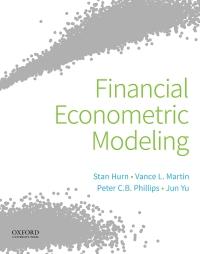This Monte Carlo experiment demonstrates the inconsistency of the ordinary least squares estimator and the efficacy of
Question:
This Monte Carlo experiment demonstrates the inconsistency of the ordinary least squares estimator and the efficacy of instrumental variables estimation for the errors in variables problem. Consider the simple linear model
\[
\begin{aligned}
& y_{t}=\beta_{0}+\beta_{1} x_{t}+u_{t} \\
& x_{t}=z_{t}+v_{t}
\end{aligned}
\]
with
\[
\left[\begin{array}{c}
u_{t} \\
x_{t}
\end{array}\right] \sim N\left[\begin{array}{cc}
\sigma_{u}^{2} & ho \\
ho & \sigma_{\epsilon}^{2}
\end{array}\right]
\]
(a) Simulate the model for \(ho=\{0.2,0.5\}\) and \(T=\{50,100,200,400\}\) with \(u_{t} \sim N(0,1), z_{t} \sim N(0,1), \beta_{0}=10\) and \(\beta_{1}=2\). For each of 1000 repetitions of the simulation store the estimate of \(\beta_{1}\) obtained by ordinary least squares estimator and instrumental variables using \(z_{t}\) as an instrument for \(x_{t}\).
(b) Summarise the results for the ordinary least squares estimator. What do you conclude about the consistency of ordinary least squares in this problem.
(c) Repeat part (b) for the instrumental variables estimator. Discuss your results.
(d) Simulate the model just once with \(T=500\).
i. Estimate the model by instrumental variables.
ii. Estimate the model using the two-step least squares approach and compare the standard errors on the parameters to those obtained in (i). Explain why the two estimates of standard error are not the same.
Step by Step Answer:

Financial Econometric Modeling
ISBN: 9781633844605
1st Edition
Authors: Stan Hurn, Vance L. Martin, Jun Yu, Peter C.B. Phillips





